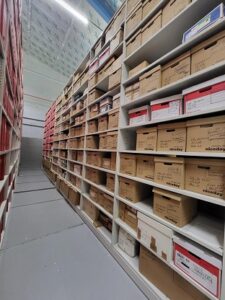By Abigail Hartley, Appraisal Archivist and Archives Collections Manager

ITI prior to processing, totalling over 70 linear metres of material
Several months ago, my colleague Jasmine Hide and I wrote two introductory posts about our new roles and what they entailed. This time, I would like to draw attention to a collection we recently appraised, that of the Information Technology Infrastructure, or, in its condensed form, ITI.
Now, it is no secret that – aside from our crucial Digital and Web Archivist team members – most archivists are not experts on the early history of computing. Having said that, for sixty years Edinburgh has prided itself on its forward-thinking approach to IT, particularly artificial intelligence. This is therefore an important collection that needed processing.
Arriving from the Department of Computer Science in 2017, the collection contains material that shows the development of the Edinburgh Regional Computing Centre, as well as the development and implementation of large-scale computing projects, services, applications, and programs from 1966 up to around 2000. It will be of particular interest to anyone researching the development of computing science, both as a practical feature in people’s lives, as well as the academic field.
